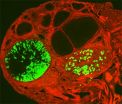(Press-News.org) AUDIO:
Humpback whale sounds were recorded in Bering Strait in October 2012.
Click here for more information.
The Arctic is home to a growing number of whales and ships, and to populations of sub-Arctic whales that are expanding their territory into newly ice-free Arctic waters.
A study of the narrow passage of the Bering Strait uses underwater microphones to track the whales by their sounds. Three years of recordings reveal more detections of both Arctic and sub-Arctic whales traveling through the narrow choke point.
Kate Stafford, an oceanographer with the University of Washington's Applied Physics Laboratory, will present the results Feb. 26 at the Ocean Sciences meeting in Honolulu.
The recordings show Arctic beluga and bowhead whales migrating seasonally through the region from the Arctic south to spend winter in the Bering Sea. They also detect large numbers of sub-Arctic humpback, fin and killer whales traveling north through the Bering Strait to feed in the biologically rich Chukchi Sea.
"It's not particularly surprising to those of us who work up in the Arctic," Stafford said. "The Arctic seas are changing. We are seeing and hearing more species, farther north, more often. And that's a trend that is going to continue."
Stafford placed microphones below the water's surface and recorded in summer and early winter from 2009 to 2012 as part of a U.S.-Russian scientific collaboration. Melodious humpback whale songs showed up regularly on recordings into late fall. Fin and killer whales, which are southern species that seldom travel into Arctic waters, were heard into early November.
"These animals are expanding their range," Stafford said. "They're taking advantage of regions in seasons that they may not have previously."
The recordings also picked up ships using the ice-free summers to travel through two international shipping lanes. This poses an increased risk of collisions between whales and ships, and of noise pollution.
"Marine mammals rely primarily on sound to navigate, to find food and to find mates. Sound is their modality," Stafford said. "If we increase the ambient sound level, it has the potential to reduce the communication range of cetaceans and all marine mammals."
The Bering Strait is famous as a land bridge that prehistoric humans used to travel from Russia to North America. Today, the waterway is 58 miles wide and maximum 160 feet deep, with about one-third of its span in U.S. waters and the rest in Russia. The two coasts are quite different, Stafford said, which makes the international collaboration essential to understanding the full environment.
A recent paper by Stafford and other scientists includes visual sightings of killer whales, a quieter southern-dwelling whale, just north of the strait in the southern Chukchi Sea. Killer whales are now seen fairly regularly in this area, which is being considered for oil and gas exploration.
"The Arctic areas are changing," Stafford said. "They are becoming more friendly to sub-Arctic species, and we don't know how that will impact Arctic whales. Will they be competitors for food? Will they be competitors for habitat? Will they be competitors for acoustic space, for instance these humpbacks yapping all the time in the same frequency band that bowheads use to communicate? We just don't know."
Stafford supports the idea of slowing ship speeds in the Bering Strait, reducing motor noise and the chance of ship strikes.
Another suggestion to protect whales builds on tagging work showing that bowhead whales tend to travel up the U.S. side on the way north in the spring and on the Russian side on their way back in the fall. The proposal suggests that ships follow the American coast in the fall and the Russian coast in the spring to reduce interactions between ships and whales.
Still to be explored is whether the increased whale travel through the region is due to rising whale populations, expanded ranges, or both. Logbooks from Soviet whaling ships in the mid-to-late 20th century report sub-Arctic whales in the region, but none were seen from about 1980 to 2010.
"The question is, are these whale populations recovering and so they're reoccupying former habitat, or are they actually invading the Arctic because they can, because there is less seasonal sea ice?" Stafford said. INFORMATION:
Collaborators on the research are Janet Clarke at Leidos Inc. and Sue Moore at the National Oceanic and Atmospheric Administration. The research was funded by the U.S. National Science Foundation and the National Oceanic and Atmospheric Administration.
For more information, contact Stafford at 206-685-8617 or stafford@apl.washington.edu.
Stafford will speak in Session #102 at the Ocean Sciences meeting in Honolulu on Wednesday, Feb. 26 at 2:45 p.m. in room 316A.
Whales, ships more common through Bering Strait
2014-02-26
ELSE PRESS RELEASES FROM THIS DATE:
NPL scientists blend synthetic air to measure climate change
2014-02-26
Scientists at the National Physical Laboratory (NPL) have produced a synthetic air reference standard which can be used to accurately measure levels of carbon dioxide and methane in the atmosphere. This will greatly help scientists contribute to our understanding of climate change.
A paper published in Analytical Chemistry describes how researchers at NPL have created a synthetic gas standard for the first time, which is comparable to the World Meteorological Organisation (WMO) scale and can be quickly produced in a laboratory and distributed, meeting growing demand.
The ...
Self-administration of flu vaccine with a patch may be feasible, study suggests
2014-02-26
The annual ritual of visiting a doctor's office or health clinic to receive a flu shot may soon be outdated, thanks to the findings of a new study published in the journal Vaccine.
The research, which involved nearly 100 people recruited in the metropolitan Atlanta area, found that test subjects could successfully apply a prototype vaccine patch to themselves. That suggests the self-administration of vaccines with microneedle patches may one day be feasible, potentially reducing administration costs and relieving an annual burden on health care professionals.
The ...
New blood analysis predicts risk of death
2014-02-26
The general state of a person's metabolism can be diversely illustrated with a new scientific blood analysis. With the aid of the analysis biomarkers predicting short-term mortality have now been discovered.
If a person belongs to a risk group based on these biomarker concentrations, he/she has a multifold risk of dying in the next five years compared to the general population. The study is based on blood samples of over 17,000 Finnish and Estonian people.
Mortality was related to four biomarkers in the blood: levels of two proteins (albumin and alpha-1 acidic glycoprotein), ...
Self-rated physical fitness in midlife an indicator of dementia risk
2014-02-26
How would you rate your own physical fitness? Is it good, satisfactory or maybe even poor? Surprisingly, your answer may reveal your future risk of getting dementia.
A recent collaborative study from Finland, involving the follow-up of 3,559 adults for 30 years, has found that a simple question about self-rated physical fitness in midlife may reveal individuals who are at an increased risk of developing dementia. Those who reported poor self-rated physical fitness in midlife, at the mean age of 50 years, were four times more likely to get dementia during the next three ...
Different eggs in adolescent girls and adult women
2014-02-26
Are the eggs produced by adolescent girls the same as the ones produced by adult women? A recent study published in Human Molecular Genetics by Professor Kui Liu from the University of Gothenburg in Sweden shows compelling evidence that there are two completely distinct types of eggs in the mammalian ovary – "the first wave" and "the adult wave".
Professor Liu's team used two genetically modified mouse models to show that the first wave of eggs, which starts immediately after birth, contributes to the onset of puberty and provides fertilizable eggs into the transition ...
Hormone therapy linked to better survival after lung cancer diagnosis in women
2014-02-26
DENVER – Survival among people with lung cancer has been better for women than men, and the findings of a recent study indicate that female hormones may be a factor in this difference. The combination of estrogen plus progesterone and the use of long-term hormone therapy were associated with the most significant improvements in survival.
The study was designed to explore the influence of several reproductive and hormonal factors on overall survival of women with non-small cell lung cancer (NSCLC). After adjusting for stage of disease at diagnosis, treatment type (surgery ...
Don't throw out old, sprouting garlic -- it has heart-healthy antioxidants
2014-02-26
"Sprouted" garlic — old garlic bulbs with bright green shoots emerging from the cloves — is considered to be past its prime and usually ends up in the garbage can. But scientists are reporting in ACS' Journal of Agricultural and Food Chemistry that this type of garlic has even more heart-healthy antioxidant activity than its fresher counterparts.
Jong-Sang Kim and colleagues note that people have used garlic for medicinal purposes for thousands of years. Today, people still celebrate its healthful benefits. Eating garlic or taking garlic supplements is touted as a natural ...
Better remote-sensing explosive detectors: The beginning of the end of full-body scanners?
2014-02-26
Standing in a full-body scanner at an airport isn't fun, and the process adds time and stress to a journey. It also raises privacy concerns. Researchers now report in ACS' The Journal of Physical Chemistry Letters a more precise and direct method for using that "terahertz" (THz) technology to detect explosives from greater distances. The advance could ultimately lead to detectors that survey a wider area of an airport without the need for full-body scanners.
R. Kosloff and colleagues explain that using THz spectroscopy by itself is challenging for sensing far-away explosives. ...
Caffeine-based gold compounds are potential tools in the fight against cancer
2014-02-26
The side effects of ingesting too much caffeine — restlessness, increased heart rate, having trouble sleeping — are well known, but recent research has shown that the stimulant also has a good side. It can kill cancer cells. Now, researchers report in the ACS journal Inorganic Chemistry that combining a caffeine-based compound with a small amount of gold could someday be used as an anticancer agent.
Angela Casini, Michel Picquet and colleagues note that caffeine and certain caffeine-based compounds have recently been in the spotlight as possible anticancer treatments. ...
MSU advances algae's viability as a biofuel
2014-02-26
EAST LANSING, Mich. — Lab success doesn't always translate to real-world success. A team of Michigan State University scientists, however, has invented a new technology that increases the odds of helping algae-based biofuels cross that gap and come closer to reality.
The current issue of Algal Research showcases the team's invention — the environmental photobioreactor. The ePBR system is the world's first standard algae growing platform, one that simulates dynamic natural environments.
Simply put, ePBR is a pond in a jar that helps identify, cultivate and test algal ...




